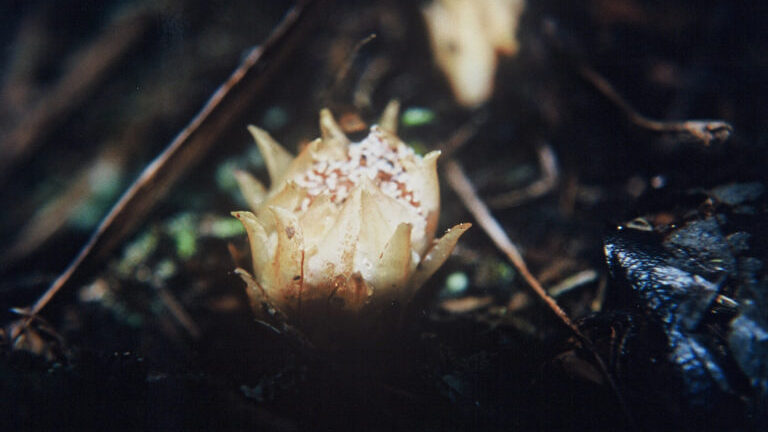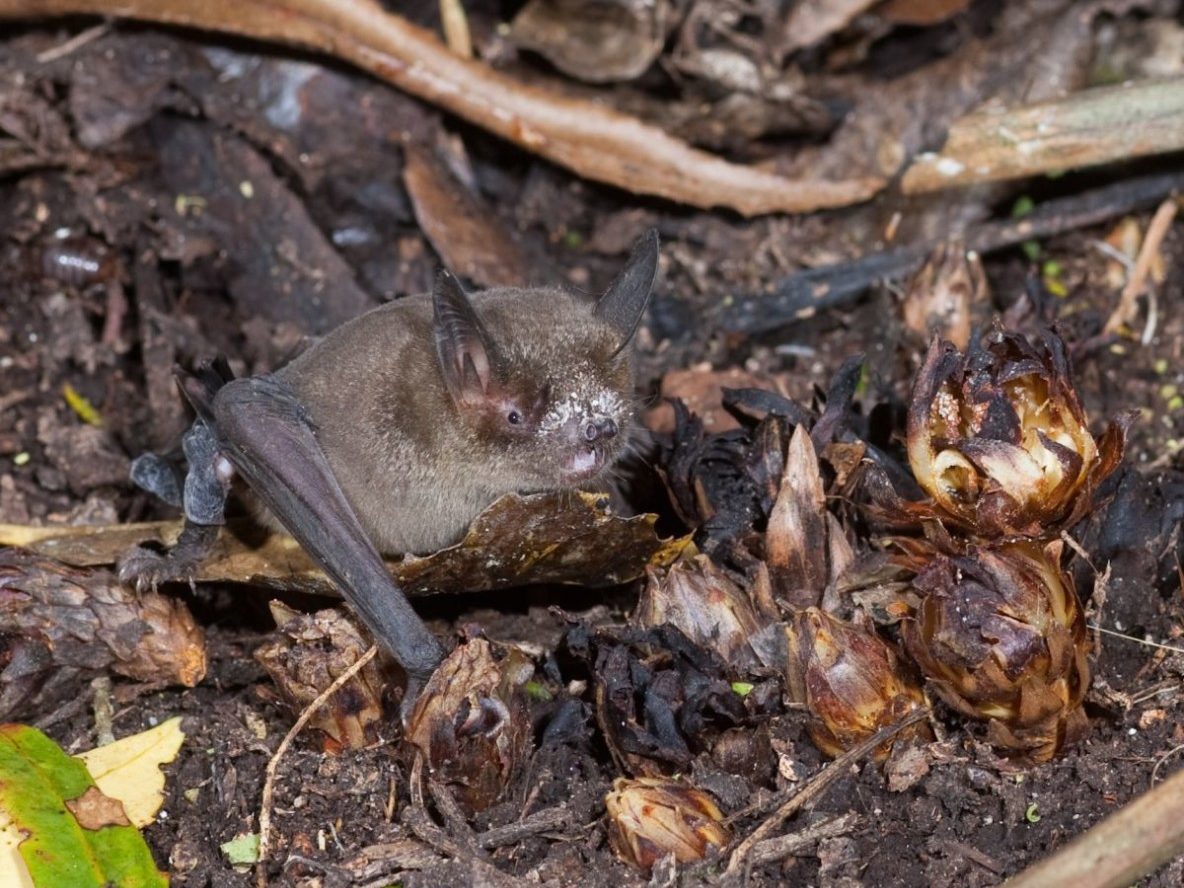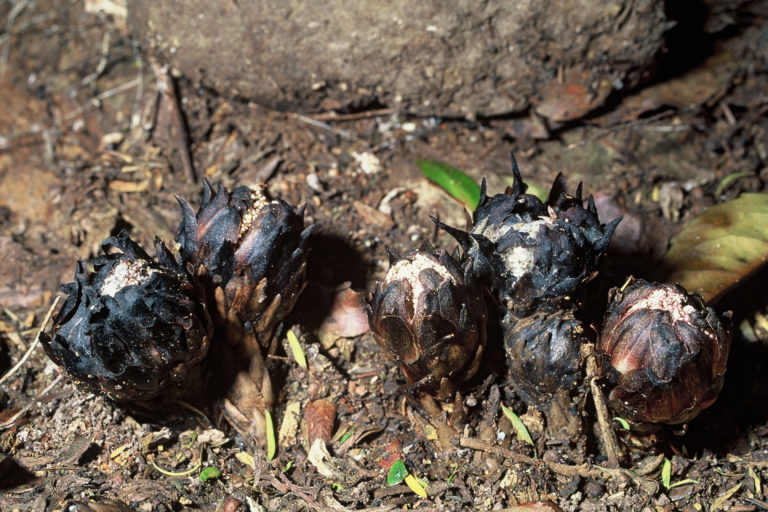Short-tailed bats are the main pollinators of New Zealand’s only fully parasitic flowering plant – the wood rose (Dactylanthus taylorii), known to Māori as te pua o te rēinga. Both the bat and the wood rose are endangered, but we still have a lot to learn about the feeding/pollinating relationship between them.

Researchers Zenon Czenze and Tertia Thurley have been investigating flower visitation by the bats and recently published the results from their study in the New Zealand Journal of Ecology.
“Dactylanthus taylorii is New Zealand’s only fully parasitic flowering plant, and the only ground-flowering plant pollinated by a bat. Dactylanthus inflorescences emerge from under the soil during late February to early May and secrete copious amounts of glucose-rich nectar that contains chemicals typical of bat-pollinated plants.”
That copious, sweet nectar hasn’t gone unnoticed by other, more recently arrived mammals, however. Possums, rats and mice also enjoy the sweet treat and can destroy flowers with their feasting. As a result, Dacylanthus now only occupies a fraction of its former range.

“The New Zealand lesser short-tailed bat (Mystacina tuberculata) feeds on a variety of insects, as well as fruit, nectar, and pollen from several plants and it is the primary pollinator of Dactylanthus. Mystacina’s mating season coincides with the flowering period of Dactylanthus and during late summer males spend a third of the night singing to attract females. Juveniles, born earlier in the year, become volant during summer and may be under greater energy constraints compared to adults due to naïve foraging behaviour. Perhaps to mitigate these increased energetic costs or augment energy reserves, both adult males and juvenile bats visit Dactylanthus more often than adult females.”
The fact that it’s favourite energy drink is becoming increasingly rare could be having an impact on bats too. But damage from invasive mammals is only one of the factors influencing the wood rose. Weather can also have an impact on yearly seed production.
“Previous work, using rotten inflorescences as a proxy for rainfall, contends that more rainfall/rotten influences negatively affects yearly seed production by Dactylanthus (Parker 2015). The author advocates that future work should quantify rainfall conditions during the flowering season to help understand its effect on Dacytlanthus.”
Not surprisingly, weather can have an effect on bat activity patterns too. Higher activity has been observed during warmer evenings, for example. Might bats also be discouraged from foraging when it rains?
“Our previous work suggests that flower visitation during a single flowering period positively correlated to temperature, but not rain. Therefore, the goal of this study was to quantify the variation in ambient temperature and rainfall during two flowering seasons of Dactylanthus and determine if these environmental conditions affected visitations by bats. We predicted that flower visitation would correlate positively with overnight ambient temperature and negatively with precipitation. Additionally, we predicted that if juveniles and adult males are under predictable and seasonal energetic shortfalls then the demographic differences in visitation we recorded in 2016 should be retained between years.”
So how do those predictions pan out?

The study was conducted over two summers of bat-courtship/wood rose flowering (February–March 2016 and 2017) in the Pikiariki Ecological Area of Pureora Forest Park.
“Pikiariki is approximately 450 ha of native, mature podocarp-hardwood forest. Half of the Pikiariki bat population are estimated to have been marked with passive integrated transponder tags (PIT-tags) as part of ongoing monitoring that started in 2012. Untagged adult and juvenile bats are PIT-tagged each year in February just prior to the Dactylanthus flowering season and during the two-year study period 977 individuals were recorded at roost trees.”
So with a ready-made population of tagged bats, the next step was to plant some bat tag receivers near the wood rose flowers to detect any bats that visited.
“From 2016–2017, during the peak Dactylanthus flowering period (i.e. 21 February–15 March), 15 of the most accessible clumps of Dactylanthus inflorescences, which bats were known to visit, were fitted with PIT-tag ring antennae. Antennae completely encircled inflorescences to ensure detection of visiting bats, and data loggers stored an individual’s unique PIT-tag number and the time of visit.”
“We recorded daily (24 hr) ambient temperature (°C) variables (e.g. daily maximum, daily minimum, daily mean) and total daily (24 hr) rainfall (mm) in Pikiariki from a central weather station approximately 2 km from roosts and feeding areas.”
Mathematical modelling was used to assess the effect of daily mean ambient temperature and total daily rainfall on (1) total number of nightly flower visits (visits per night) and (2) total number of individuals that visited plants each night (bats per night).
“From 21 February–15 March 2017 we recorded 15 tagged individuals at nine inflorescences (0 adult females, 6 juvenile females, 1 adult male, 8 juvenile males). We recorded the most visits by juvenile males (n = 108) followed by juvenile females (n = 97), and adult males (n = 18), and did not record any visits from adult females. We combined these data with those from 2016 (24 individuals; 4 adult females, 6 juvenile females, 6 adult males, and 8 juvenile males) when we recorded the most visits by adult males (n = 197), followed by juvenile females (n = 149), juvenile males (n = 64), and adult females (n = 4).”
Individually identified bats made multiple visits per night to feast on the copious, glucose-rich nectar.
“In 2017, we recorded an average of 11.8 ± 2.4 visits per night, and 14.8 ± 12.2 in 2016 and a maximum of 35 visits per night from 5 individuals in 2017, and 44 visits from 6 individuals in 2016.”
So how did those visits correlate with temperature and rainfall? Weatherwise, 2017 turned out to be a much wetter summer than 2016.
“During the sampling seasons, the mean ambient temperature in 2016 (15.4 ± 1.8°C) was similar to 2017 (15.2 ± 2.1°C). However, the average daily rainfall in 2016 (0.6 ± 1.4 mm) was c. 8.9-fold lower than in 2017 (5.3 ± 12.7 mm). In 2016 we recorded four days with daily rainfall > 1 mm compared to 11 days in 2017. Further, in the 2016 season we did not record any rainfall events that exceeded 6 mm of daily rainfall; however, during the 2017 season there were 6 rainfall events that exceeded a daily total of 10 mm.”
When results were analysed, it turned out that both bats per night and visits per night were best explained by total daily rainfall, with fewer visits to flowers during days with heavier rainfall. Wetter summers, may therefore discourage the wood rose’s main pollinator, leading to less seed production for that year. Wet weather can also directly damage the flowers themselves.

“For Dactylanthus, a greater proportion of rotting male inflorescences can be observed during rainy flowering periods, which likely negatively affects yearly seed production. Anecdotally, we observed a similar pattern with more rotted flowers during the wetter 2017 than the previous year.”
“Unfortunately, it is still unclear whether the increased rainfall of 2017 directly influenced flower survival as we were not able to quantify the survival duration of flowers or seed production in Pureora between years. Future research should, during the flowering period, aim to quantify seed production, weather conditions, and Mystacina activity concurrently to tease apart the most influential variables and thus aid in Dactylanthus conservation.”
This research was carried out in the North Island, but interestingly short-tailed bats in the South Island have shown a different weather response.
“During winter in the South Island, the population of Mystacina do not appear to be rain averse and were actually more likely to be active when there was > 1 mm of rain However, increased bat activity during light rain may be a response to falling barometric pressure, which coincides with greater flying insect abundance, and may serve as a cue for increased foraging success.”
“Unlike the periods of light rainfall Christie and Simpson (2006) reported, the heavier rainfall observed Pureora in 2017 likely limits an individual’s energetic foraging returns and increases energetic costs due to greater heat loss when fur is wet. Alternatively, if individuals are active during the heavier rain, the lower visitation rates may be due to the reduced quality of Dactylanthus inflorescences. Dactylanthus inflorescences will begin to rot less than a day after rain and this may be accelerated with heavy or consistent rain.”
After a rain burst the entire inflorescence turns brown and disintegrates quickly. A second rain burst speeds the disintegration process even more. The bat-attracting scent is also affected.
“Older male inflorescences have a different nectar scent from those that are just emerging, while those that are disintegrating have no discernible nectar scent. Healthy Dactylanthus produce a sweet-smelling nectar, a trait that promotes bat visitation. The scent of healthy flowers may serve as a signal to bats about the nectar content and the potential energetic benefits associated with feeding from flowers. If heavy rainfall changes the scent and thus the attractiveness of Dactylanthus, which, in turn, reduces visitation by bats, it could partially explain the lower seed set of Dactylanthus during seasons with heavy rainfall.”
The absence of adult females feeding on wood rose nectar is also interesting.
“During the flowering season adult females are under comparatively lower energetic pressure than adult males (due to costs associated with singing) or juveniles (due to naïve foraging behaviour). Here we confirm, and indeed strengthen, the findings of Czenze and Thurley (2018) as we recorded no visits from adult females in 2017 and found that visitations were dominated by juveniles and adult males. Juveniles and adult males may visit Dactylanthus more often to help recoup energetic losses as carbohydrate-rich nectar can be easily digested and mobilised.”
The authors concede there may be other explanations, however.

“Since we monitored inflorescences nearest communal roosts, and thus also near many male singing trees, males may have been feeding from flowers closest to their singing trees and skewing the results. Additionally, the high proportion of juvenile bats we recorded may be explained by young bats remaining near communal roosts due to underdeveloped flying ability. However, if proximity to inflorescences is driving the greater visitation by males and juveniles, it raises the question why are hundreds of adult females occupying the nearby communal roosts virtually absent from our records? Future studies, where feasible, should attempt to outfit Dactylanthus further away from communal roosts to determine if females have patches in different areas of their home-range which they frequent.”
While the results to date are interesting, there is still more work to be done before the complex bat/wood rose/weather relationship is fully understood.
“Admittedly, there are several factors that constrained our study, and the results presented must be interpreted with caution. First, our data are limited to only two years of visitation data from one population; obviously it would be ideal to continue this type of study in multiple populations over the course of several years. Second, we were unable to quantify other potential environmental correlates like windspeed or operative temperature at the inflorescence, which would have made our models more robust and potentially changed our results. However, our results suggest that Dactylanthus visitation by bats is more strongly influenced by rainfall than temperature and help to elucidate how environmental conditions can affect the unique mutualistic relationship between Dactylanthus and Mystacina. For Dactylanthus conservation to continue to be successful, more work is required to determine the specific effects of environmental conditions and their ecological correlates to Dacytlanthus reproduction.”
The full research report is published in the New Zealand Journal of Ecology and is freely available online.

